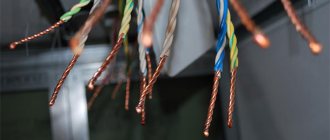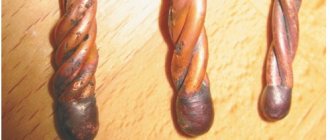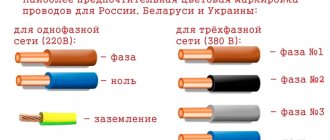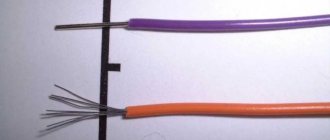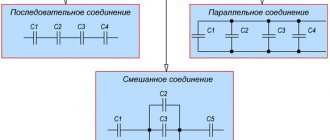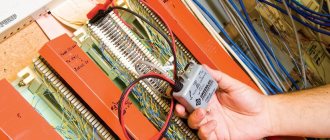Modern man cannot imagine his life without electrical appliances. They meet at every step. But in order for them to work, electrical power is required. In the article we will understand how to correctly connect the wires in the junction box in order to eliminate the possibility of a short circuit, or vice versa - a bad contact.
To distribute wires to points you need to be able to connect them in a junction box. Source strojdvor.ru
What is a junction box
Everyone knows that the wires from the panel do not run in a straight line, but are distributed among the rooms. Electrical wiring outlet points are mounted in each of them: socket, switch, light bulb.
To facilitate the distribution procedure, there are distribution boxes. Each wire in a wire connector is laid according to long-established rules. The wiring is laid under the ceiling, departing about 15 cm from it. The cable, which is led to a certain point, must extend perpendicularly from the main power line. A box will come in handy to hide all the connections.
There are two types of such boxes:
- Internal - in this case, the entire device is hidden in the wall of the room and only the cover is brought to the surface, so that later an electrician can easily access the connected node.
- The external type of boxes allows you to install it directly on the wall of the room.
Distribution boxes can be different in shape: rectangular or round, but still, each of them has four outlets. Sometimes there are devices with additional holes. Each outlet has a fitting or thread for attaching a corrugated hose. This state of affairs is excellent for repairing or replacing electrical wiring.
Distribution boxes come in different shapes. Source kogalym.kembrik.pro
Pros of using a junction box:
- Easy access to components in case of breakdown or for checking voltage;
- Most often, it is at the connection point that electricians make mistakes, but in the distribution box it is easiest to check all the nodes;
- Such boxes protect premises from possible fire;
- Boxes also help save money on purchasing multi-core cables.
Recommendations for selection
In order to choose the right pad, you should adhere to the following rules:
- Determine the functional purpose of the component.
- Take into account the cross-section of the conductor and its quantity.
- Select the method of installation work.
- After the above provisions , it is necessary to decide on the most optimal model.
Particular attention should be paid to the characteristics of the plate, which conducts electric current. The base shows the maximum value, which is measured in volts. It is these restrictions that determine the type of conductor.
Removing insulation
Before connecting the wires in any of the eight known ways, the electrician will have to carry out preparatory work, namely, clean the core from the protective film. For the job you only need a mechanic's knife. Anyone can do this operation, but you need to be careful not to damage the wiring core. Therefore, you need to listen to the recommendations of experienced electricians and follow all their advice:
- The cable is placed on a table or flat board;
- Press firmly onto the board with your finger;
- The knife is pressed into the insulation at an angle;
- When removing the insulating ball, the wire should move, but not the knife;
- Having made a circular cut, the sheath is easily stretched and removed from the cable.
Electricians use strippers to strip insulation from cables.
Source yandex.ru Modern electricians use a stripper to remove the protective layer. This tool can be mechanical, semi-automatic or automatic. Its advantage is that the vein remains unharmed after the operation.
Tips from experienced installers
There are many controversial issues both in connection methods and in the use of individual mounting products. But a number of rules apply to absolutely all craftsmen who do electrical installations.
For example, it is strictly prohibited to twist aluminum conductors with copper ones . The process of rapid oxidation leads to the destruction of the commutation and the creation of a dangerous point, which can spark or flare up at any time.
When using electrical tape, overlap the wraps. One layer is not enough, it is better to go along the connection 2-3 times, making sure to make the last turn on the insulation
Single conductors in screw terminals are held loosely. Therefore, it is recommended to bend the stripped end in half or make an arbitrary loop out of it.
At the end of the work, be sure to check the reliability of the connections - lightly tug the wires. It happens that the switching is unsuccessful, and the core simply slips out of the terminal block.
If the volume of the distribution box allows, for example, the panels accommodate a lot of wires and devices, then leave the cable with a reserve. Sometimes switching is required and the extra length is useful if the connections are permanent or burnt.
Wire connection methods
The connection of wires in the junction box is done taking into account many factors:
1. Type of material from which the wires are made:
- aluminum;
- copper;
- steel and alloys.
2. From the environment in which the wiring will be located:
- Street;
- premises;
- underground wiring;
- running the cable underwater.
3. Number of wires used.
4. Whether the cross-section of the cores matches or not.
Taking into account all these aspects, the installer chooses the method in which the contact assembly will be mounted in the junction box. There are eight ways to connect wires.
Twist
One of the easiest and most accessible ways is to twist wires. Our grandfathers used it. Despite the fact that this method has been used for a long time, it is not the best and is completely prohibited in the rules for installing electrical appliances. The reason for this ban is that properly twisted wires were used in those days only for watching TV and listening to the radio, as well as for lighting the room. Thus, it did not bear the load, unlike modern apartment equipment.
Twisting is the easiest way to connect wires. Source zdorovaya-eda.com
See also: Catalog of companies that specialize in electrical work.
Still, twisting is necessary. It is the basis for other electrical wiring methods such as soldering and welding.
Pros of twisting:
- There is no additional cost to purchase additional accessories.
- You don't need to put any effort into doing this job.
- It is possible to connect several cables together.
Minuses:
- This method is the most unreliable for use in modern electrical wiring.
- It cannot be used to connect cables whose cores are made of different metals.
- Twisting cannot be used for modern use, since when replacing wiring, the ends cannot be separated several times in a row. On the other hand, twisting cannot be called a one-piece method, since it unwinds easily
During installation, the twisting must be done with high quality so that it does not have to be redone later. To do this, use pliers to clamp the wires at one end and use the other to make rotational movements. This way the wires are twisted evenly.
The twist must be insulated to protect it from the external environment, which can cause it to oxidize and become unusable. To do this, use thermal tubes, placing it first on one of the cables and then on the connection point. If everything is done correctly, the wiring will serve for several years.
Twisting as a basis for connecting cables using soldering. Source viva-el.by
Soldering
The soldering method involves connecting all wire strands using molten solder. Most often, wires made of copper are soldered using this method. But today, various fluxes have been invented that can also solder aluminum cores. However, electricians do not approve and refrain from making such connections. But sometimes there are situations when there is nothing left to do but connect copper and aluminum wires, using special fluxes.
Advantages:
- connecting wires to each other using soldering is much more reliable than twisting;
- You can solder multi-core cables together;
- more reliable in operation and does not require additional checks;
- refers to one of the cheapest ways to install electrical components.
Flaws:
- requires a lot of time and labor, since the material for work must be properly prepared;
- This method requires a qualified worker who knows how to work with a soldering iron.
- even taking into account the laboriousness of soldering, one cannot help but admit that this method is much more effective than twisting.
Scotch-lock
Couplings of this type are for one-time use. Used for wires with low operating currents (telephone lines or wires for low-power LED lamps).
These clamping couplings make connections by means of a mortise contact. The wires don't even need to be stripped before connecting. They are inserted directly into the insulating layer into adhesive tape and crimped with pliers. The plate, which has cutting contacts, cuts into the insulating layer, due to which contact between the cores occurs.
In addition to the fact that stripping of cores is not required, adhesive locks have a number of other advantages:
- low cost;
- versatility;
- no special devices are needed, crimping is done with ordinary pliers;
- waterproof (there is a hydrophobic gel inside the coupling, which protects the contact connection from moisture and corrosion).
- If the Scotch-lock coupling needs to be replaced, it is simply cut out and a new one is installed in its place.
Modern technologies
Modern methods of connecting wires include the use of ready-made additional accessories, which are not only easy to use, but also serve as an insulating element. The most popular among them are:
- terminal blocks;
- PPE caps;
- self-clamping terminals;
- Lever terminal blocks.
Terminal blocks
The terminals are made of plastic. Inside them there is a brass insert with bolts on both sides. During the joining process, the core, cleared of insulation, is inserted under the insert and pressed tightly with bolts.
Blocks are a very convenient accessory for connecting wires. Source stip.pl
Advantages:
- low cost of the device;
- easy execution of work;
- the knot turns out to be reliable and strong;
- Both copper and aluminum wires are connected together.
Flaws:
- often unscrupulous manufacturers produce defective products;
- only two cables are installed;
- aluminum and multi-core wiring does not allow the use of blocks, since aluminum itself is fragile and often breaks, and the cores of a multi-core cable are thin and can slip out from under the bushings;
- Despite the reliability, this method is significantly inferior to soldering and welding.
Wago terminal blocks
This is the most reliable device for connecting electrical wires. In this case, the veins are fixed using a spring mechanism. A special lever is provided for this. Thanks to this, you can connect any type of wiring, both single-core and multi-core. Aluminum and copper wires are also easily secured.
Important! There are two types of Wago terminal blocks on sale. Some of them are disposable, others are reusable. When installing electrical wiring, it should be taken into account that the disposable blocks will need to be replaced in case of repair work. Reusable ones are much more expensive, but they can be removed from the unit and put on again.
Wago pads are the most reliable.
Source wgspb.ru Advantages:
- Wires made of the same material, as well as from different ones, are connected.
- A node is created with several cores at the same time.
- In stranded wires, the strands do not fray or break.
- The pads are small in size and easily fit into the junction box.
- The work is done quickly and reliably.
- The product is of high quality.
- The block is equipped with a hole for an indicator in case of checking the voltage in the network.
Flaws:
- High price.
Soldering tips
Another way to use the tip is to solder it. To do this you need:
- stripped copper cable;
- tip designed for soldering. It is distinguished by a hole near the flat part and a thinner wall;
- bath of molten tin;
- a jar of phosphoric acid;
- a jar of soda solution.
Carefully! Wear protective glasses and gloves!
In order to solder the tip, the cable is cleared of insulation along the length of the tubular part and inserted into the tip. Then the tip is successively immersed in orthophosphoric acid, in molten tin for a time sufficient for the acid to boil away and the solder to flow into the tip. This is checked by periodically briefly removing it from the solder. After impregnating the tip and cable with solder, the tip is dipped in a soda solution. This is done to neutralize acid residues. The cooled tip is washed with clean water and is ready for further work. Such a tip can be connected to aluminum busbars and lugs without the use of adapter washers.
Connecting wires whose cores have different cross-sections
To work with such wiring you will need to use Wago terminal blocks. Moreover, they have holes for wires of different thicknesses. They can also be soldered together.
Important! In the case when it is necessary to connect aluminum and copper wires with different cross-sections, special Wago terminal blocks are used, which have a built-in device that protects the metals from oxidation.
Terminal blocks are used to connect wires with different cross-sections.
Source news.rambler.ru If you have multi-core and single-core wiring, then again you can’t do without Wago. Only this method will be the most reliable compared to the other methods described above. You should not skimp on the safety of your home.
Sleeves
The third simple way to connect conductors is crimping with sleeves.
GML sleeves are most often used for joining copper wires. Deciphered as:
- Gilsa _
- Copper _
- L narrowed
For connecting pure aluminum - GA (aluminum sleeve):
To switch from copper to aluminum, special adapters GAM:
What is the crimping method? Everything is quite simple. Take two conductors and strip them to the required distance.
After this, on each side of the sleeve, the conductors are inserted inside, and the whole thing is crimped with press pliers.
Despite its obvious simplicity, there are several rules and nuances in this procedure, if not followed, you can easily ruin a seemingly reliable contact. Read about these mistakes and rules on how to avoid them in the articles “5 Rules of Crimping” and “Crimping Insulated Tips, Sleeves and Terminals”.
To work with conductors of large sections 35mm2-240mm2, a hydraulic press is used.
Up to cross-sections of 35mm2, you can also use a mechanical one with a large span of handles.
The sleeve must be crimped two to four times, depending on the cross-section of the wire and the length of the tube.
The most important thing in this work is to choose the correct sleeve size.
For example, when connecting a monocore, the sleeve is usually taken to a smaller cross-sectional size.
And in this way you can connect several conductors at one point at the same time. In this case, only one sleeve will be used.
The main thing is to completely fill its internal space. If you are crimping three conductors at the same time, and you still have voids inside, then you need to “fill” this free space with additional pieces of the same wire, or with conductors of a smaller cross-section.
Only after this can you press.
After crimping, such a connection must be insulated. The most convenient way to do this is with a heat-shrinkable tube HERE.
There are tubes with an adhesive base. When heated, this glue flows out and ensures the tightness of the connection.
Insulation using a thermal tube is also a fairly simple process. In the absence of a gas burner or hair dryer, even a lighter is sufficient for small sections.
Sleeve crimping is one of the most versatile and reliable connections, especially when it is necessary to extend the cable, including the input cable.
In this case, the insulation turns out to be almost equivalent to the main one, when also using the outer tube HERE as a casing.
Of course, you won’t use either PPE or Wago for these purposes, but GML cartridges are just the thing! At the same time, everything comes out compact and can be easily reduced, either in a groove or in a cable channel.

